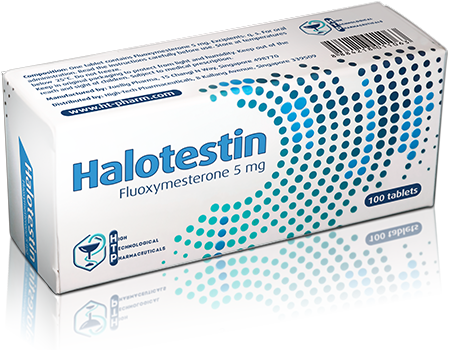Halotestin

Indication:
Fluoxymesterone, sold under the brand name Halotestin is an androgen and anabolic steroid medication which is used in the treatment of low testosterone levels in men, delayed puberty in boys, breast cancer in women, and anemia.
Contraindications:
- Known hypersensitivity to the drug
- Males with carcinoma of the breast
- Males with known or suspected carcinoma of the prostate gland
- Women known or suspected to be pregnant
- Patients with serious cardiac, hepatic or renal disease
Administration:
The dosage will vary depending upon the individual, the condition being treated, and its severity. The total daily oral dose may be administered singly or in divided (three or four) doses.
Daily dose of 5 to 20 mg will suffice in the majority of patients. It is usually preferable to begin treatment with full therapeutic doses which are later adjusted to individual requirements. Priapism is indicative of excessive dosage and is indication fortemporary withdrawal of the drug.
Medical action:
Endogenous androgens are responsible for normal growth and development of the male sex organs and for maintenance of secondary sex characteristics. These effects include growth and maturation of the prostate, seminal vesicles, penis, and scrotum; development of male hair distribution, such as beard, pubic, chest, and axillary hair; laryngeal enlargement, vocal cord thickening, and alterations in body musculature and fat distribution. Drugs in this class also cause retention of nitrogen, sodium, potassium, and phosphorus, and decreased urinary excretion of calcium. Androgens have been reported to increase protein anabolism and decrease protein catabolism. Nitrogen balance is improved only when there is sufficient intake of calories and protein.
Androgens are responsible for the growth spurt of adolescence and for eventual termination of linear growth, brought about by fusion of the epiphyseal growth centers. In children, exogenous androgens accelerate linear growth rates, but may cause disproportionate advancement in bone maturation. Use over long periods may result in fusion of the epiphyseal growth centers and termination of the growth process. Androgens have been reported to stimulate production of red blood cells by enhancing production of erythropoietic stimulation factor.
During exogenous administration of androgens, endogenous testosterone release is inhibited through feedback inhibition of pituitary luteinizing hormone (LH). At large doses of exogenous androgens, spermatogenesis may also be suppressed through feedback inhibition of pituitary follicle stimulating hormone (FSH).
Inactivation of testosterone occurs primarily in the liver.
The half-life of fluoxymesterone after oral administration is approximately 9.2 hours.
Precautions:
Women should be observed for signs of virilization which is usual following androgen use at high doses. Discontinuation of drug therapy at the time of evidence of mild virilism is necessary to prevent irreversible virilization. A decision may be made by the patient and the physician that some virilization will be tolerated during treatment for breast carcinoma.
Patients with benign prostatic hypertrophy may develop acute urethral obstruction. Priapism or excessive sexual stimulation may develop. Oligospermia may occur after prolonged administration or excessive dosage. If any of these effects appear, the androgen should be stopped and if restarted, a lower dosage should be utilized.
Side effects:
Female: the most common side effects of androgen therapy are amenorrhea and other menstrual irregularities; inhibition of gonadotropin secretion; and virilization, including deepening of the voice and clitoral enlargement. The latter usually is not reversible after androgens are discontinued. When administered to a pregnant woman, androgens can cause virilization of external genitalia of the female fetus.
Male: Gynecomastia, and excessive frequency and duration of penile erections. Oligospermia may occur at high dosage.
Overdosage:
There have been no reports of acute overdosage with the androgens.